Karate Belt Colors Explained: The Complete Belt Order from White to Black
November 18th, 2025

The karate belt system is one of the most recognizable parts of martial arts, but most people only know the basics. White means beginner and black means expert. What they miss is that every color in between has a specific purpose, a history, and a meaning that reflects a student's progress. Whether you are a parent trying to understand your child's rank, a new student curious about how the levels work, or a longtime martial artist looking to compare systems, understanding the karate belt order helps everything in training make more sense. This guide breaks down the traditional belt colors, the progression from one level to the next, and how different schools approach the ranking system.
Karate Belts in Order

Karate belt colors were never meant to be decorative. The order they follow represents a clear progression in knowledge, responsibility, and maturity. Although each school may add stripes or insert additional levels, most systems follow a recognizable progression from light to dark. This shift in color represents a student's movement from a blank starting point to a deeper, more seasoned grasp of the art. The most common order used in many dojos is white, yellow, orange, green, blue, purple, red, brown, and black.
The logic behind this progression goes back to early karate training in Okinawa, where rank was not originally defined by color at all. Belts were introduced later as karate spread across Japan and instructors needed a way to organize larger classes. Lighter colors were assigned to beginners because they symbolized openness and the beginning of learning. As students advanced, the belts transitioned into richer and darker hues to reflect maturity, discipline, and increasing responsibility. By the time a student reaches the brown belt levels, they have absorbed enough training to move beyond basic techniques and start refining their personal style.
Seeing all the karate belts in order also helps new students understand what lies ahead. It gives parents a clear picture of how their children will progress and shows older beginners that improvement happens one level at a time. Every color marks a milestone. Each belt level represents a deeper commitment to training, and the journey from white to black is designed to teach confidence as much as technique. This structure keeps students motivated and creates a shared framework across most karate schools, even when minor variations exist.
Traditional Karate Belt Colors and What They Represent
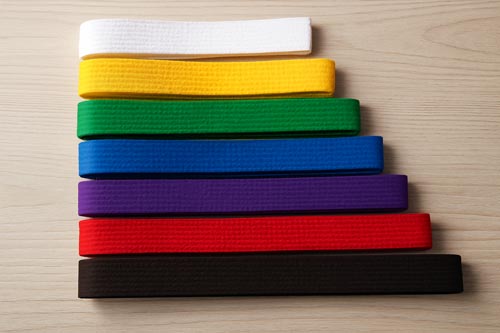
Karate belt colors are often seen as simple markers of rank, but each shade carries meaning that reflects a student's growth. The traditional sequence moves from lighter colors to darker ones because this visually mirrors the way knowledge develops. Early levels introduce basic stances, blocks, and strikes, while later colors mark the transition into combinations, timing, sparring concepts, and deeper martial arts principles. When students move through the colors in order, they are following a structure that has guided generations of practitioners.
White represents a clean start. Yellow and orange show the first signs of understanding as students begin to absorb technique and discipline. Green marks noticeable progress as movements become stronger and more controlled. Blue and purple introduce refinement, where students learn to apply techniques with greater precision. Red demands intensity and focus, showing that a student is preparing for more advanced responsibilities. Brown signals maturity, strength, and readiness for the challenges of black belt training. Finally, black is not an end point. It represents a student who has built a strong foundation and is now ready to begin studying the art in a deeper way.
Although the meanings can vary slightly between organizations, the general ideas remain consistent. Belt colors are designed to keep students motivated, help instructors organize their classes, and create a visible structure that makes progress easy to understand. When viewed together, the colors tell a complete story about the path from novice to advanced student, and why each level feels different from the one before it.
Why Karate Belt Colors Progress from Light to Dark
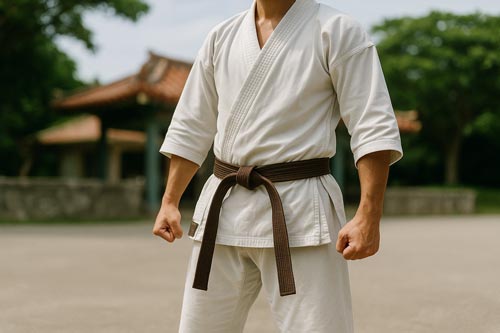
The progression of karate belt colors from white to black is not accidental. It reflects the way traditional martial arts viewed learning long before belts existed. Early karate training in Okinawa followed a simple path. Students trained under a single instructor for years, slowly absorbing fundamentals until they were ready for more advanced material. When colored belts were eventually introduced in Japan, instructors needed a visual system that matched this idea of gradual development. Lighter colors were chosen to represent the early stages of learning, where everything is new and untested. Darker shades were assigned to more experienced levels because they symbolized depth, strength, and accumulated understanding.
There is also a practical side to the color progression. New students make a lot of mistakes, so lighter belts show wear and dirt quickly. As students gain control, their techniques become cleaner and more precise. By the time someone reaches the middle colors, they have enough discipline and awareness that their training reflects greater consistency. Darker belts hold up better under the higher demands of advanced practice, where training sessions involve more intensity, sparring, and complex combinations. The shift in color becomes a mirror to the physical and mental changes that happen over time.
Another reason for the gradual darkening of colors is the psychological effect it has on students. Beginners see the brighter belts above them and understand that progress is within reach. Intermediate students look toward the darker belts and recognize the work still ahead. Advanced students look back at the lighter colors and remember where they started. This built-in motivation is one of the reasons the belt system has lasted so long. It creates structure, clarity, and a sense of purpose for students of all ages.
How Karate Belt Levels Reflect a Student's Growth

Karate belt levels are designed to mark more than technical progress. They reflect the personal development that happens as students learn to control their bodies, understand timing, and build discipline. Each belt level introduces new expectations. Beginners learn simple stances and strikes, but as they move into the middle ranks, they are expected to show sharper technique, a stronger sense of rhythm, and a deeper awareness of how movements connect. By the time a student reaches the upper colors, their training shifts toward strategy, fluid combinations, and the ability to adapt under pressure.
One of the reasons karate belt levels work so well is that they give instructors a framework for teaching. A white belt may be working on balance and coordination, while a green belt is refining hip rotation and adding speed. A purple belt might be developing timing in sparring, while a brown belt is learning how to stay calm when an opponent applies pressure. These layered expectations help students grow at a natural pace. No level is skipped, and no one advances without demonstrating the qualities associated with the next color.
The differences between belt levels also help students stay motivated. When a student receives a new belt, it marks a clear moment of achievement. It confirms that the work they have put into training is paying off. This creates momentum that carries them into the next stage of learning. It also builds a sense of belonging within the dojo. Students begin to recognize their place within the group and see how their progress fits into the larger structure of the art. Over time, these levels become part of a larger identity, shaping the way students carry themselves both inside and outside the dojo.
How Long It Takes to Move Through Karate Belt Levels
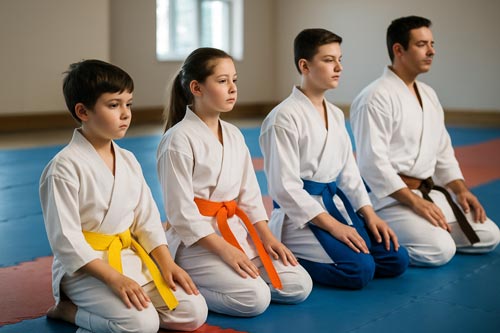
Progression through the karate belt levels does not happen at the same pace for everyone. Some students advance quickly because they train consistently and practice at home, while others take more time to refine fundamentals. In most traditional dojos, beginners spend at least a few months at each belt as they build coordination, strength, and confidence. This early phase focuses heavily on repetition. Students drill stances, punches, blocks, and kicks until they become familiar enough to perform them without hesitation.
As students climb into the middle belt colors, the pace often slows. Green, blue, and purple belts bring more demanding expectations. Techniques need to be sharper, forms need to be performed with rhythm and control, and sparring becomes a larger part of training. In many schools, it takes six months to a year to move through these intermediate levels. The time spent here has a purpose. It gives students the chance to develop timing, distance management, and the ability to remain calm when reacting to an opponent.
Red and brown belts are usually the longest phases in a student's journey. These levels require maturity and consistency, along with a deeper understanding of the art. Students must show that they can apply technique under pressure and maintain strong basics even when fatigued. It is not unusual for a student to remain in the brown belt ranks for a year or more before being invited to test for black belt. This extended period helps ensure that the student is ready for the challenges that come with the highest level of training.
Although the timeline varies between schools, the overall structure remains the same. Each belt level takes longer than the one before it because the expectations continue to rise. This is one of the reasons the karate belt order feels meaningful. Students earn each color with real effort, and the time invested at every stage makes advancement feel significant. By the time someone reaches black belt, they have not only improved physically but have also learned the patience and consistency needed for long-term martial arts training.
Why Belt Colors Can Vary Between Karate Styles
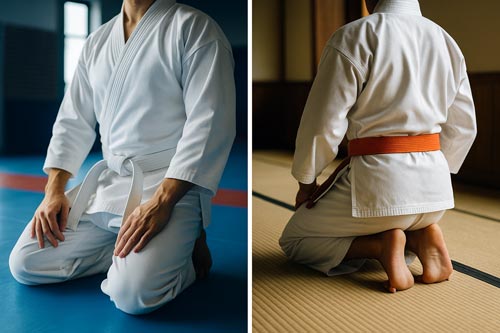
While the traditional karate belt order is widely recognized, there is no single universal system used by every dojo. Different styles developed their own variations as karate spread across Okinawa, mainland Japan, and the rest of the world. Shotokan schools, for example, often include both purple and red in their sequence, while some branches of Goju Ryu use only a few colors before moving students into brown belt levels. Kyokushin programs sometimes introduce additional intermediate ranks to reflect the heavy conditioning and sparring that define their training. These differences do not change the purpose of the belt system. They simply reflect the history and teaching methods of each style.
The order of colors can shift based on the curriculum a school wants to emphasize. Some dojos place green earlier or later in the sequence depending on when they expect students to show stronger control of technique. Others include stripes or tips to mark progress between full belt tests. These additions allow instructors to reward consistency and effort without advancing a student before they are ready for the next full level. In schools with large class sizes, small variations like this help keep students motivated and ensure that everyone has a clear sense of where they stand.
Even with these variations, the overall philosophy remains the same. Lighter colors represent early learning, middle colors show growing competence, and darker colors signify maturity and leadership. Whether a dojo includes nine colors or only a handful, the goal is identical. Students follow a path that encourages discipline, patience, and steady improvement. Understanding that belt colors vary between styles helps students appreciate the diverse history of karate and recognize that progress depends more on personal development than the specific color around their waist.
What Reaching Black Belt Really Represents

Many people assume that black belt marks the end of karate training, but most traditional instructors see it as the beginning of serious study. Everything before black belt is focused on building a foundation. Students learn how to stand correctly, how to move their hips for power, how to block without losing balance, and how to strike with intention. These skills take years to develop, which is why the belt colors gradually darken as students move toward the highest level. When someone finally reaches black belt, it means they have built a strong enough base to start exploring the deeper parts of the art.
Black belt training introduces concepts that are harder to understand at the earlier levels. Timing becomes more nuanced, footwork becomes more efficient, and students learn how to adapt to unfamiliar situations during sparring or self defense drills. In many dojos, new black belts are encouraged to slow down and observe how techniques connect rather than simply focusing on speed or impact. They begin to notice details that were easy to overlook in the lower ranks. This shift from physical learning to conceptual understanding is part of what separates black belt practice from the earlier stages.
Another defining part of black belt training is responsibility. Students at this level are often expected to help junior members, assist in teaching classes, and set an example of discipline within the dojo. Younger students watch how black belts behave, how they show respect, and how they respond to challenges. This leadership component strengthens the community and reinforces the values that karate is built upon. As black belts continue to train, they discover that their role carries weight. Their progress influences the atmosphere of the entire school.
Because of this, the meaning of black belt goes beyond physical skill. It reflects persistence, respect for the art, and the willingness to keep learning long after the early excitement fades. Students who reach this level understand that progress does not stop just because they have earned a dark belt. Instead, they step into a stage of training that requires patience, curiosity, and long term commitment. This is why most instructors describe black belt not as an achievement, but as a doorway to a much larger world of study.
Why the Karate Belt Order Still Matters Today
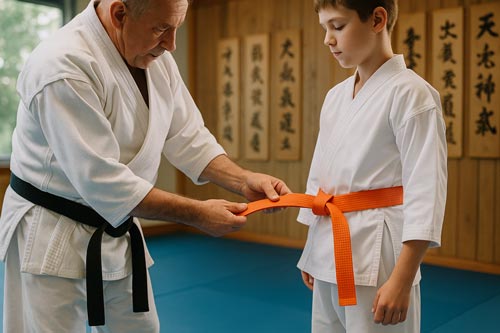
Even though modern karate has evolved and spread across the world, the belt order continues to serve an important purpose in every dojo. It gives students a clear structure to follow. Beginners know where they stand, intermediate students see the path ahead, and advanced students understand the responsibility that comes with higher ranks. This progression helps maintain consistency, especially in classes with a wide range of ages and experience levels. Without a defined belt order, the flow of training would be harder to organize, and students would have fewer reference points as they grow.
The belt order also supports motivation. When students train for months to earn a new color, the moment they tie it around their waist feels meaningful. It marks real progress that is visible to classmates, instructors, and parents. These milestones help keep students engaged during difficult phases of learning, especially when training becomes more complex or physically demanding. The emotional connection to each belt color is part of what keeps people committed to karate for years rather than months.
Beyond motivation and structure, the belt order preserves the history of the art. Every color carries ideas that have been passed down through generations of teachers. Learning the meaning behind each level helps students appreciate where their training comes from and how it fits into the broader world of martial arts. This sense of continuity is one of the reasons karate remains so respected. Students are not just learning techniques. They are participating in a tradition that has shaped the character of countless practitioners across decades.
Even in dojos that modify the exact colors or add stripes between ranks, the underlying purpose stays the same. The belt order guides students through a progression that builds skill, confidence, and self awareness. It gives structure to teaching, creates shared expectations within the dojo, and strengthens the connection between past and present. As long as karate continues to be practiced, the belt order will remain a central part of how the art is passed from one generation to the next.
How Dojos Use the Belt System to Build Community

The belt system does more than guide individual progress. It also shapes the culture of the entire dojo. Students quickly learn that each color represents a shared experience. Everyone remembers what it felt like to be a white belt trying to figure out the basics, or an orange belt learning their first combinations, or a brown belt preparing for the pressure of advanced training. These shared memories help students connect with one another, regardless of age or background. When a new student joins, they step into a structure that has already brought countless people together.
In many dojos, higher ranked students play an active role in helping lower ranked students. Brown belts and black belts assist with warm ups, demonstrate combinations, or work with beginners who need extra guidance. This creates a natural mentorship chain that strengthens the sense of community. Students learn not only from the instructor but also from those just a few levels ahead of them. The belt system transforms the dojo into a place where everyone contributes something, and everyone has someone to learn from.
Promotion days also bring the dojo together in a meaningful way. Students line up by belt color, show respect to their instructor, and support one another as each person demonstrates what they have learned. When a student ties on a new belt for the first time, the entire room often reacts with pride. These shared moments create bonds that extend far beyond routine training. They give students memories that stay with them for years. By reinforcing these traditions, the belt system helps the dojo become a place where people feel supported, encouraged, and connected to a larger purpose.
Where to See Common Karate Belt Colors Used in Dojos
Learning about the karate belt order is helpful, but seeing the belts themselves can make the progression even clearer. Most dojos use the same core colors for their ranking system, even when they add stripes or intermediate levels. If you want to look at the belt colors typically used in karate programs or explore options for training and testing, you can view them on our karate belts page. This gives a useful visual reference for students, parents, and instructors who want to compare the colors discussed throughout this guide.
The Lasting Value of the Karate Belt System
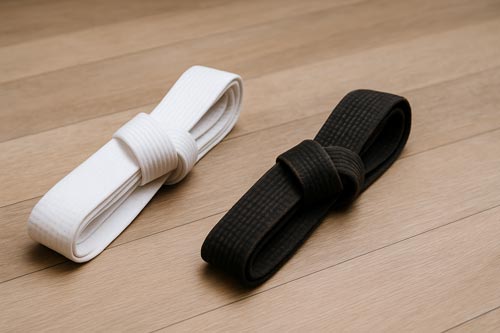
The karate belt system continues to matter because it gives students a clear path to follow. Every color marks a moment of progress, whether it is a beginner learning their first stance or an advanced student refining technique during sparring. These levels make the journey easier to understand and help students see how far they have come. When the colors are viewed as steps in a long progression rather than isolated achievements, the belt order takes on a deeper meaning.
Karate belts also help maintain the culture of the dojo. They show who has experience, who is still learning the basics, and who can help guide others. This structure makes training smoother and strengthens the sense of community shared by everyone on the mats. The belt colors and the order they follow tie students to the history of the art and remind them that the traditions behind karate were shaped by generations of practitioners.
For anyone beginning karate today, the belt system provides motivation, clarity, and a sense of purpose. For experienced students, it reflects years of steady work and personal growth. No matter where someone starts or how quickly they advance, the belt colors remind them that progress in karate is built step by step. It is a journey that encourages discipline, patience, and respect for the art, and it continues to guide students in dojos around the world.
You May Also Be Interested In:
Leave a Reply
























